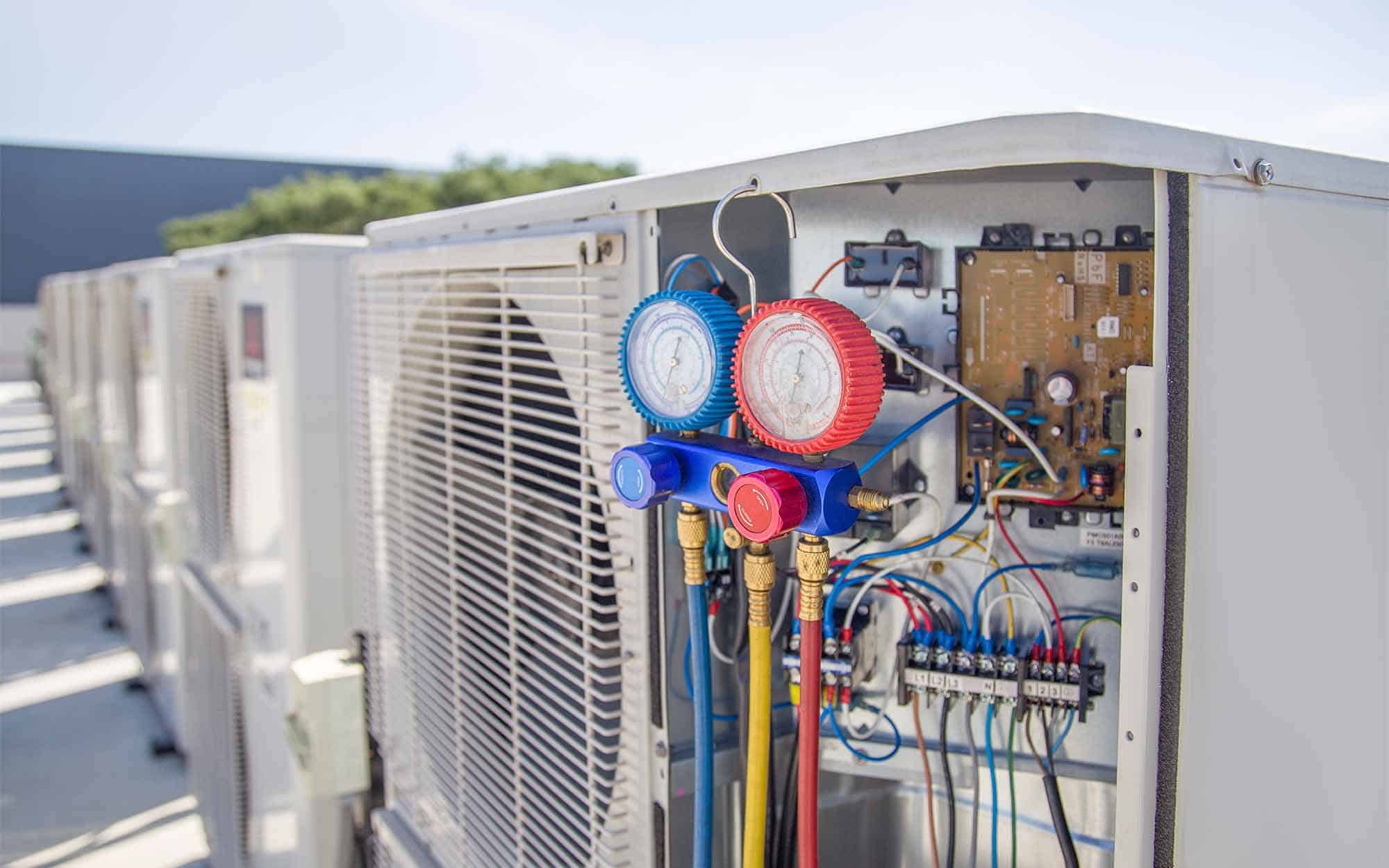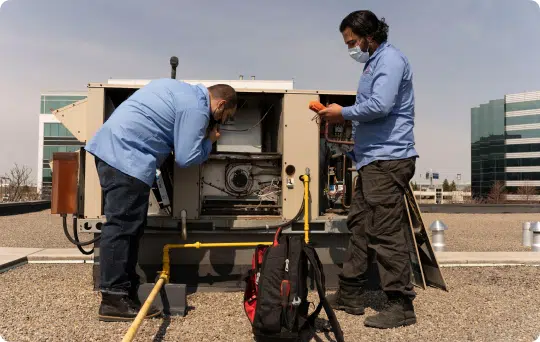Just How a Warmth Pump and Heater Interact to Enhance Your Home's Heating Efficiency
Recognizing just how a warm pump and furnace collaborate is necessary for house owners seeking efficient heating services. Each system has its staminas, offering a well balanced approach to home comfort. The heat pump masters modest temperature levels, while the heating system provides rapid warmth throughout severe cold. This synergy not only minimizes energy prices but additionally enhances the life-span of both appliances. What aspects influence this partnership, and how can homeowners optimize their advantages?
Comprehending Warmth Pumps: How They Function
Although lots of people might be not familiar with their internal operations, heat pumps play a crucial function in modern-day heater. These devices operate by moving warm from one area to one more, utilizing the principles of thermodynamics. In chillier months, a heatpump removes heat from the outside air, ground, or water, and transfers it inside your home to heat the space. Conversely, during warmer months, it can reverse the procedure, functioning as an ac system by eliminating heat from inside to the outside.Heat pumps consist of an evaporator, compressor, expansion, and condenser shutoff. The cooling agent within the system soaks up warmth as it vaporizes at reduced temperature levels and stress. The compressor then enhances the pressure and temperature of the refrigerant, allowing it to launch warmth as it condenses. This reliable procedure can greatly reduce energy consumption contrasted to typical home heating approaches, making warm pumps a sustainable choice for climate control in homes.
The Duty of Heaters in Home Home Heating
Heating systems play an important function in home heating by supplying a reliable resource of heat throughout the colder months. They operate by creating warmth via burning or electrical resistance, distributing it throughout the home through ducts or glowing systems. The efficiency of a heating system is typically measured by its Annual Fuel Usage Effectiveness (AFUE) score, which suggests how effectively the device converts gas into heat.Furnaces can utilize numerous power resources, consisting of all-natural gas, oil, lp, or electrical power, allowing home owners to select one of the most appropriate alternative for their requirements. Unlike heatpump, which might have a hard time in severe chilly, heaters preserve consistent performance, ensuring that indoor temperatures continue to be comfortable regardless of exterior conditions. In addition, contemporary furnaces frequently come furnished with innovative technology, such as wise thermostats and variable-speed blowers, boosting their efficiency and responsiveness. This adaptability makes heating systems an essential component in comprehensive home heating methods.

Benefits of Utilizing Both Equipments Together
Combining the staminas of both heating systems and heatpump can cause an extra effective and efficient home heating solution. Utilizing both systems allows homeowners to capitalize on the heatpump's energy efficiency during milder temperature levels while relying upon the furnace for even more severe cold conditions. This twin technique can significantly decrease energy costs, as heatpump take in much less electrical energy than typical home heating techniques when temperatures are moderate.Additionally, making use of both systems with each other can enhance convenience levels in the home. Warmth pumps can supply constant, even home heating, while heating systems can rapidly raise ambient temperature levels when needed. The combination of both systems can expand the life expectancy of tools by decreasing wear and tear on each device, as they share the workload. Eventually, home owners can delight in a balanced, cost-effective heating remedy that adjusts flawlessly to varying weather condition problems, making sure a warm and inviting home throughout the wintertime months.
How Warm Pumps and Furnaces Enhance Each Other
They create a complementary heating system that makes best use of efficiency and convenience when house owners integrate warmth pumps and heating systems. Heatpump run by moving warmth from the outside air or ground, making them extremely efficient in moderate environments. They excel during milder temperatures, offering economical home heating. Conversely, heating systems produce warmth with burning or electrical resistance, delivering strong, instant warmth throughout severe cool conditions.The combination of these two systems enables vibrant modifications based upon temperature fluctuations. During warmer months or milder winter days, the heat pump can take the lead, conserving power and lowering prices. As temperature levels decline, the furnace can perfectly engage, making sure consistent warmth throughout the home. This synergy not just enhances power use however additionally improves the lifespan of both systems, as each device operates within its excellent efficiency range. Together, they create a balanced environment that adapts to differing climate demands.
Optimizing Performance: Tips for Homeowners
Home owners can improve their heating performance via numerous sensible strategies. Establishing a normal upkeep routine, incorporating clever thermostat modern technology, and implementing efficient insulation and securing services are key steps. These actions not only boost comfort yet likewise lower energy prices.
Routine Upkeep Schedule
To assure maximum home heating efficiency, developing a regular upkeep schedule is essential for any type of home. Property owners should focus on regular assessments of both heatpump and heating systems to ascertain peak performance. This includes altering air filters each to three months, as blocked filters can substantially decrease effectiveness. In addition, scheduling professional maintenance a minimum of annually permits service technicians to identify and attend to possible issues prior to they escalate. Property owners ought to also clean up the heatpump's outdoor device to avoid debris accumulation that can impede air movement. By sticking to a regular maintenance schedule, house owners not just improve their heater' performance but also extend their lifespan, causing higher convenience and minimized power expenses throughout the chillier months.
Smart Thermostat Combination
Incorporating a wise thermostat into a home heating system can greatly boost power effectiveness, especially as it allows for specific control over temperature level settings. These devices can learn the home owner's timetable and choices, immediately adjusting the temperature level to optimize comfort while reducing power usage. As an example, they can decrease home heating during times when the home is empty, lowering unnecessary consumption. Many clever thermostats likewise supply real-time energy usage information, allowing homeowners to make weblink enlightened choices regarding their home heating practices. In addition, remote gain access to via mobile phone apps enables customers to adjust setups from anywhere, guaranteeing the home is cozy upon return. In general, smart thermostat assimilation check out here not only enhances convenience but significantly contributes to energy financial savings and efficiency.
Insulation and Securing Solutions
Smart thermostats play a vital role in energy performance, but their efficiency can be substantially enhanced by appropriate insulation and sealing options. Home owners ought to focus on shielding walls, attics, and floorings to decrease heat loss. High-quality insulation products, such as spray foam or fiberglass, can substantially improve thermal resistance. In addition, sealing gaps around windows, ducts, and doors avoids chilly air seepage and warmth retreat. Weatherstripping and caulking are effective approaches for dealing with these leaks - heat pump replacement ooltewah tn. Normal inspections for air leakages, in addition to the usage of blower door examinations, can aid recognize trouble locations. By buying insulation and securing, house owners can enhance the performance of their heater, eventually bring about lowered power intake and reduced energy bills
Typical Myths Regarding Warmth Pumps and Furnaces
What misconceptions surround heatpump and heating systems? Lots of people incorrectly believe that heat pumps are ineffective in chillier climates. In truth, contemporary heatpump are designed to run effectively even in reduced temperature levels, offering reputable heating throughout winter season. An additional typical myth is that heaters are constantly a lot more efficient than heatpump. Nonetheless, this depends upon the specific power sources and effectiveness ratings of the devices in inquiry. Some might additionally think that utilizing both systems all at once is unneeded, but actually, this combination can enhance heating effectiveness, particularly during severe climate condition. Furthermore, people often think that heat pumps need consistent maintenance, when truthfully, they have similar maintenance requires to traditional heating unit. By disproving these myths, house owners can make even more informed decisions concerning their home heating choices, inevitably resulting in enhanced convenience and power efficiency in their homes.
Maintenance Factors To Consider for Combined Equipments

Regularly Asked Inquiries
Can Warmth Pumps Work Properly in Extremely Cold Climates?
Heatpump can have a hard time in exceptionally cold climates because of lowered efficiency and heat removal constraints. Improvements in technology have actually led to models designed for better performance in such problems, enhancing their practicality in rough environments.
The Length Of Time Do Warm Pumps and Furnaces Commonly Last?
Heat pumps usually last 15 to two decades, while furnaces have a lifespan of 15 to three decades. Normal upkeep can expand their long life, ensuring reliable operation and minimizing the requirement for premature replacements.

What Is the Typical Cost of Setting Up Both Systems?
The typical expense of mounting both a heatpump and a furnace normally ranges in between $5,000 to $10,000 - heat pump service. Variables influencing this expense consist of system size, installment complexity, and regional labor prices
Are There Tax Obligation Motivations for Using Energy-Efficient Home Heating Equipments?
Lots of home owners ask about tax motivations for energy-efficient furnace. Various federal and state programs typically use rebates or credit reports, urging the adoption of sustainable innovations to minimize power intake and advertise environmental responsibility.
Exactly how Do I Pick the Right Dimension Heat Pump and Furnace?
Selecting the appropriate dimension heat pump and furnace includes determining the home's square video, considering insulation quality, and assessing regional climate. Consulting an expert can assure ideal system performance and energy effectiveness based on specific needs. heat pump service. Recognizing how a warm pump and heating system job together is vital for house owners looking for efficient heating options. In cooler months, a warm pump essences heat from the outdoors air, ground, or water, and transfers it inside to heat the living room. When home owners incorporate warm pumps and furnaces, they create a corresponding heating system that makes the most of performance and comfort. Heat pumps run by moving warm from the outdoors air or ground, making check this site out them highly reliable in moderate environments. Warm pumps can have a hard time in incredibly cold environments due to minimized effectiveness and heat removal restrictions